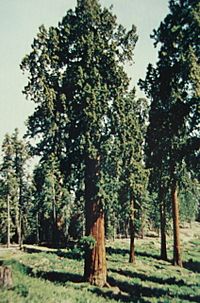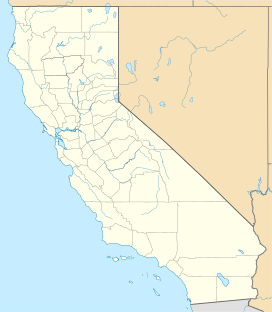Black Mountain Grove facts for kids
Quick facts for kids Black Mountain Grove |
|
|---|---|

Black Mountain Beauty, the largest tree in the grove
|
|
| Map | |
| Geography | |
| Location | Tulare County, California, United States |
| Coordinates | 36°06′16″N 118°39′19″W / 36.10444°N 118.65528°W |
| Elevation | 6,400 ft (2,000 m) |
| Area | 3,310 acres (1,340 ha) |
| Ecology | |
| Dominant tree species | Sequoiadendron giganteum |
The Black Mountain Grove is a huge forest filled with over 500 giant sequoia trees. It sits on the slopes of Black Mountain, between the Middle and South Forks of the Tule River in California. This amazing grove is about 19.3 miles long. It is the sixth largest giant sequoia grove in the world!
Part of the grove is on the Tule River Indian Reservation. Other parts are in the Giant Sequoia National Monument or owned by private groups. The grove covers about 3,310 acres. You can reach it by road or by hiking. Summers here are hot and dry, which can increase the risk of wildfires. Winters are cold and fresh. The Black Mountain Grove is famous because it helped stop the cutting down of trees in sequoia groves. It also played a big part in creating the Giant Sequoia National Monument.
A Look at History
The Black Mountain Grove has faced challenges, especially from fires. In 1928, a large wildfire burned over 2,600 acres. This fire left a big open space in the forest.
Later, people fought to protect these special trees. In 1987, a group called the Sierra Club took legal action. They wanted to stop logging (cutting down trees) in the groves. The court decided that the groves should be returned to their natural state.
In 1990, an agreement was made to protect the groves even more. This agreement stopped all timber harvesting inside the groves. It also made the protected areas bigger. In 1992, President Bush visited the giant sequoias. His visit helped make sure these trees were fully protected. This meant no more logging, mining, or building in the groves.
Sadly, wildfires continued to be a threat. In 2008, another fire burned about 12% of the grove. Then, in 2017, the Pier Fire swept through a large part of the grove. This fire killed 53 giant sequoias that were very wide. Thirty-one of these trees were over 10 feet across! This high number of deaths was due to a lot of dead wood on the ground. Climate change also made the fires worse.
Amazing Wildlife and Plants
Before laws protected the trees, many non-sequoia trees were cut down. Over 500 acres of forest were destroyed. More than 70% of the groves were logged.
Today, the forest is home to many different kinds of trees. You can find ponderosa pine trees and willow trees. There are also dogwood trees and white fir trees. Other trees include black oak and incense cedar. The rarest tree here is a very large sugar pine. It grows on the north side of the forest. Smaller plants like ferns, grasses, and forbs also grow on the forest floor.
Fighting Wildfires
The Black Mountain Grove is always at risk from fires. Fires can spread from nearby areas like Long Canyon. There used to be a lot of dead wood and dry plants in the grove. This "fuel" had not been removed since 2003. If a fire started, it could burn a huge part of the sequoias.
Because of this danger, a plan was made to reduce the fuel. This plan included removing some of the dense dead wood. Unfortunately, this heavy fuel load still caused two big wildfires in 2008 and 2017. Climate change has also made wildfires happen more often. It has also made them more intense and powerful.
Famous Trees to See
The Black Mountain Grove is home to several incredible giant sequoia trees. Each one has its own unique story or feature:
- Black Mountain Beauty: This is the biggest known sequoia in the grove. It has a huge volume of 32,224 cubic feet!
- Patriarch II: This tree is the second largest giant sequoia in the grove.
- Blasted Mammoth: This is the third largest giant sequoia. It might have once been the biggest tree in the grove. Its top broke off about 90 feet above the ground, but it is still alive!
- Flower Pot Tree: This giant sequoia has a Pacific dogwood tree growing right out of its top branches.
- Snaggle-Top: This giant sequoia has a very unique and easily recognizable shape.
- Twisted Harlequin: This giant sequoia has beautiful red and pink-colored bark. The bark twists up most of its height.


